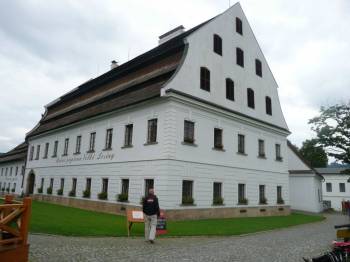Velké Losiny belongs among the most visited sites at the foothills of Jeseníky mountains. It is in the valley of the Desná river.
Velké Losiny are known not only for its rich and interesting history, centuries-old spa tradition, but also a number of historical monuments.
Quite rightly belongs to them also Handmade paper mill, which was on the estate of the Lords of the Moravian Žerotína founded in the late 16th century.
Handmade paper mill was built at the site of a former flour mill by John younger of Žerotín. According to the testimony of springs paper mill started production as one of the companies developing the suzerain economy sometimes between the years 1591-1596.
For the first time, the existence of a paper mill was proven by the oldest watermark from 1596 well-known as a Žerotín blazon - a lion with a crown standing on three hills.
From its establishment until second half of the 18th century was linked with the fate of dominion and his Žerotín holders.
Over the centuries the possession paper mill was replaced by a variety of stationery families and masters. Already in 1603 John the younger of Žerotín emfyteuticaly company sold to the first known stationer Andrew Kluge.
Throughout the 17th and 18 century paper mill supplied especially writing, scratch paper and paperboard their surroundings. Some people who did business in the stationary there were not too successful .
In the history of paper mills also affected the local infamous witch inquisitorial process for the last quarter of the 17th century , when in 1680 one of their first victims became the wife of stationer Barbora Göttlicherová.
In 1729, the lords of the manor to the mill acquired a revolutionary invention - hollander beater to prepare paper pulp, probably as the first device of its kind in Moravia. Despite the efforts of Žerotín owners to improve and modernize production processes, the local stationery who was the tenant, failed to succeed in the competition of their close competitors, especially paper mills Šumperk.. Perhaps because in 1778 the Earl of John Louis of Žerotín company sold stationery champion Matthias Werner younger. Who after a long time led to a period of prosperity and prosperity. It was in this period turn of the 18th and 19 century that the sets of objects handmade paper mill got their late Baroque and Classicism style.
The expansion of industrial paper production in the mid-19th century was in the Europe-wide the cause several production and sales crisis in paper factories. This led to their rapid demise.
In Velké Losiny the production of handmade paper managed to maintain thanks to the entrepreneurship of Anton Schmidt older, whose family bought the mill in 1855.
In addition to bleach textile and paper production there were in 1913 put into operation and hydroelectric power.
Discovery of excellent filtration properties of hand-made paper and later its renaissance in artistic circles allow stationery of traditional craft in Velké Losiny survive difficult periods and transfer due to its originality and quality up to the present.
In 1949 the paper mill became part of the national enterprise Olšanské paper mill, later a joint stock company , engaged in paper production in several industrial machinery, paper mills in the Šumperk . Since 2006, an independent company based Handmade Paper Factory Losiny as
Velké manufactory is now one of the oldest still operating businesses of its kind in Europe. Handmade paper , there are still produced in the traditional procedure of cotton and linen. For its high quality and durability centuries is mainly used in the visual arts, for significant personal and business correspondence, ceremonial purposes , to print bibliophile and also in book arts and restoration practice . Handmade papers and today's assortment of exclusive products have gained a permanent place popular with fans of traditional Czech handicrafts.
Since the mid- 70th 20th century , the entire area several stages of costly renovations and repairs , which continues even today . Unique area major monuments which particularly for more than four centuries of continuity of traditional handmade paper production have no parallel on the whole central Europe. In 2002 the Government of the Czech Republic declared it for a national monument .
